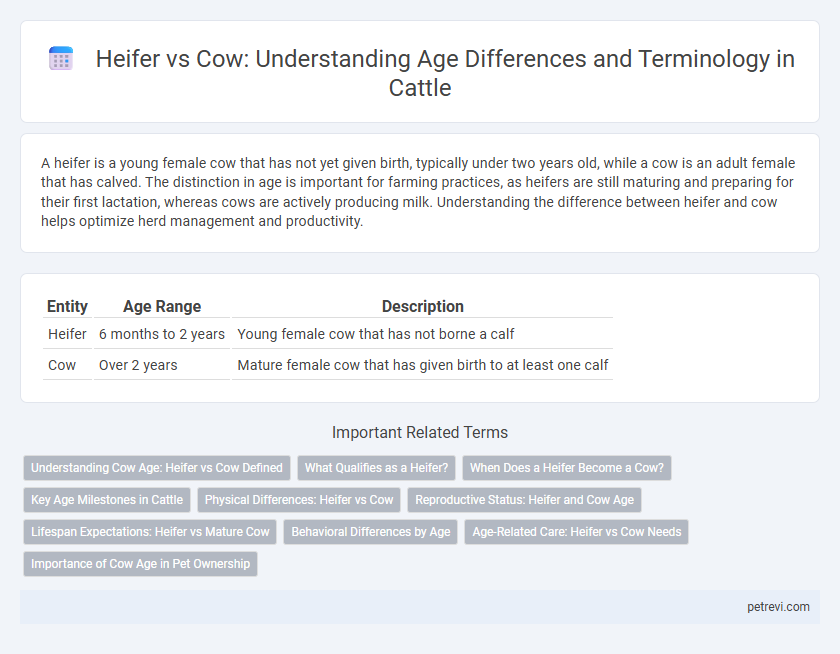A heifer is a young female cow that has not yet given birth, typically under two years old, while a cow is an adult female that has calved. The distinction in age is important for farming practices, as heifers are still maturing and preparing for their first lactation, whereas cows are actively producing milk. Understanding the difference between heifer and cow helps optimize herd management and productivity.
Table of Comparison
| Entity | Age Range | Description |
|---|---|---|
| Heifer | 6 months to 2 years | Young female cow that has not borne a calf |
| Cow | Over 2 years | Mature female cow that has given birth to at least one calf |
Understanding Cow Age: Heifer vs Cow Defined
Heifers are young female cattle that have not yet borne a calf, typically under two years of age, marking the early stage of a cow's reproductive life. Cows are mature female cattle that have given birth to at least one calf, usually over two years old, indicating full reproductive maturity. Understanding the distinction between heifer and cow aids in accurate age classification and management in cattle farming.
What Qualifies as a Heifer?
A heifer is a young female cow that has not yet borne a calf, typically under two years old and before her first calving. In cattle farming, the distinction between a heifer and a cow is based primarily on reproductive status rather than age alone. Understanding this difference is crucial for livestock management, especially in breeding and dairy production.
When Does a Heifer Become a Cow?
A heifer becomes a cow after she has given birth to her first calf, typically around two years of age depending on breed and management. The transition marks her ability to produce milk and contribute to herd reproduction. Age alone does not define this change; reproductive status is the key factor distinguishing a heifer from a cow.
Key Age Milestones in Cattle
Heifers typically reach key age milestones such as puberty around 6 to 12 months and first calving by 24 months, marking their transition into cows. Cows, on the other hand, are mature females over 24 months old with a history of calving, contributing to herd productivity through consistent milk production and calf rearing. Understanding these age milestones is crucial for effective cattle management and optimizing reproductive performance.
Physical Differences: Heifer vs Cow
Heifers, young female cattle under two years old that have not yet borne a calf, typically exhibit a leaner body with less developed udders and smaller horns compared to mature cows. Cows, having calved at least once, show more pronounced physical traits such as fuller udders, broader hips, and a stockier frame due to age and reproductive maturity. These physical differences serve as key indicators for farmers distinguishing between heifers and cows based on age and reproductive status.
Reproductive Status: Heifer and Cow Age
Heifer refers to a young female bovine that has not yet borne a calf, typically under two years old and pre-reproductive or in early reproductive phases. Cows are mature female bovines that have calved at least once, with reproductive status indicating active breeding capability and age generally over two years. Understanding the distinction between heifer and cow age is crucial for managing reproductive cycles and maximizing herd productivity in cattle farming.
Lifespan Expectations: Heifer vs Mature Cow
Heifers, typically under two years old and not yet having borne calves, have a lifespan expectation slightly shorter than mature cows due to their developmental stage. Mature cows, aged between three to ten years, usually exhibit greater longevity and productivity, with lifespans averaging 15 to 20 years depending on breed and management practices. Optimal nutrition and health monitoring significantly enhance the lifespan of both heifers and mature cows in dairy and beef operations.
Behavioral Differences by Age
Heifers, typically under two years old, exhibit higher levels of curiosity and social play behaviors compared to mature cows, reflecting their developmental stage and reproductive immaturity. Mature cows display more established social hierarchies and exhibit calmer, more predictable behaviors due to experience and hormonal changes associated with adult reproduction. Behavioral differences by age influence management practices, with heifers requiring more careful social integration and cows benefiting from stability in herd dynamics.
Age-Related Care: Heifer vs Cow Needs
Heifers, typically under two years old, require specialized age-related care focused on growth, nutrition, and development to prepare them for breeding. Mature cows, usually over two years old and having calved, need different management practices emphasizing lactation support, health maintenance, and reproductive efficiency. Understanding these distinct age-related needs is crucial for optimizing herd productivity and animal welfare.
Importance of Cow Age in Pet Ownership
Cow age plays a crucial role in pet ownership, as it directly impacts behavior, health, and care requirements. A heifer, typically under two years old and not yet having calved, requires different attention compared to a mature cow, influencing daily management and long-term bonding. Understanding the distinction between heifer and cow helps pet owners provide age-appropriate nutrition, handling, and veterinary care to ensure well-being.
Heifer vs Cow for Cow Age Infographic

 petrevi.com
petrevi.com